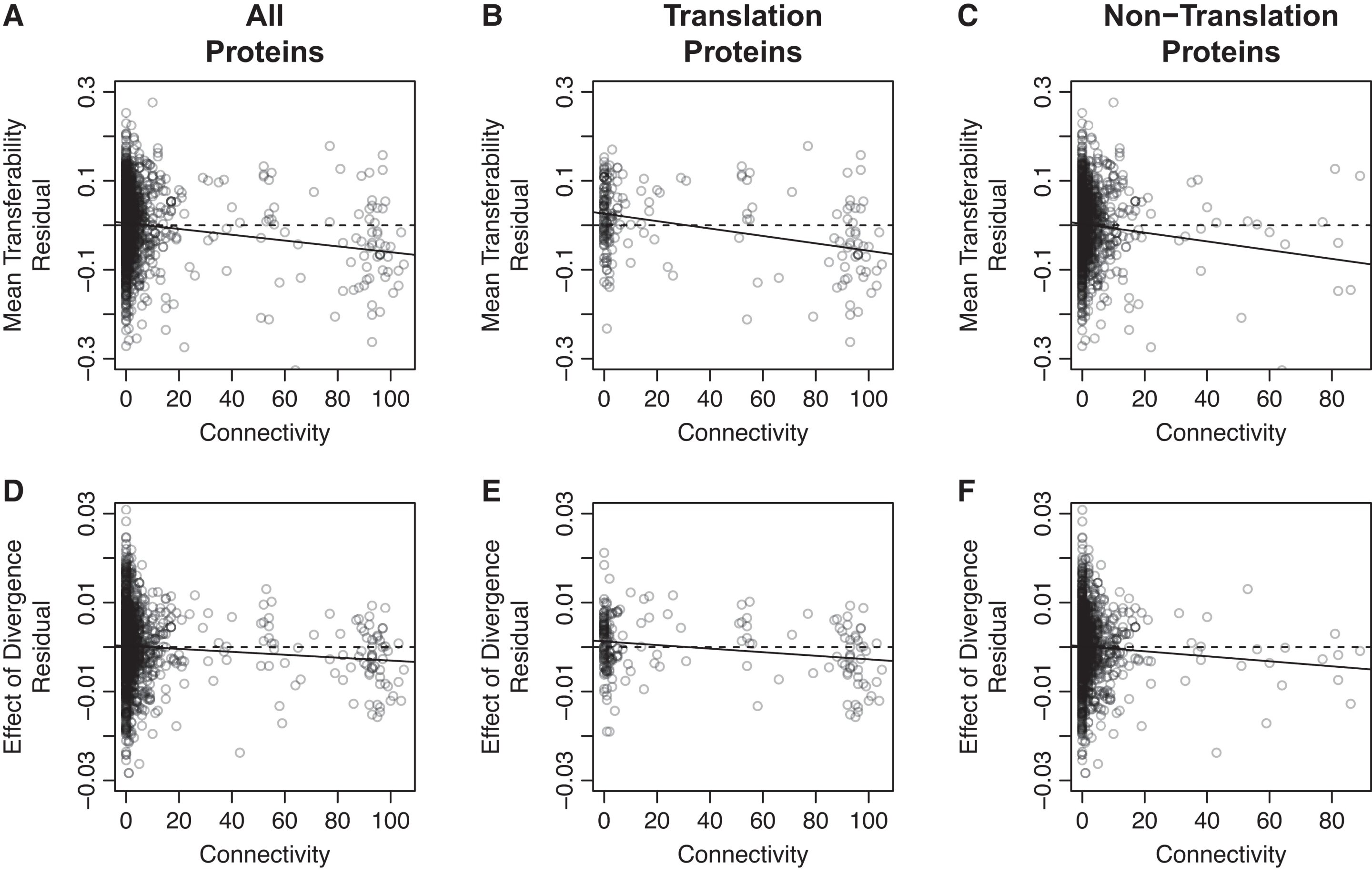Tests of the balance and connectivity hypotheses were conducted to examine the transferability of genes through horizontal gene transfer (HGT). The study analyzed the mean transferability and the effect of divergence on transferability, taking into account factors like native expression level and COG functional category. The plots displayed the deviation of each gene’s value from the expected value based on its native expression level and COG category. The study included all genes, translation proteins only, or all genes except translation proteins. Linear regression models were used to determine the best fit, and dashed horizontal lines at zero were included for reference. This research was conducted by scientists from the University of North Carolina and published in Genome Biology and Evolution.
Horizontal gene transfer is a phenomenon that challenges conventional understanding of evolutionary mechanisms. Unlike vertical transmission, which involves the transfer of genes from parent to offspring, HGT allows for the exchange of genetic material laterally between different species. Microbial evolution heavily relies on HGT, with 10-20% of bacterial genomes’ protein-coding genes attributed to this process. While HGT is less prevalent among eukaryotes, it enables bacteria and archaea to acquire new traits such as antibiotic resistance and metabolic capabilities, enhancing their adaptability to varying environments.
The recent study titled “Empirical evidence that complexity limits horizontal gene transfer” delved into the factors influencing the transferability of genes through HGT. Researchers from the University of North Carolina, led by Christina Burch and Corbin Jones, investigated how a gene’s transferability is affected by sequence divergence and the number of interaction partners it has (connectivity). Moreover, the study explored how gene divergence and connectivity interact to influence transferability. Previous studies have identified a link between gene transferability and protein connectivity, but the underlying mechanism has remained unclear. The study proposed two hypotheses: the Balance Hypothesis and the Complexity Hypothesis. The Balance Hypothesis suggests that transferred genes may disrupt the balance of expressed proteins, while the Complexity Hypothesis proposes that transferred genes may fail to participate in normal protein-protein interactions. Distinguishing between these hypotheses can be achieved by examining the magnifying effect of divergence on the relationship between connectivity and transferability.
To address these hypotheses, Burch and her team reanalyzed existing data in a novel way. They used data from the sequencing of early bacterial and archaeal genomes, in which the genome of interest was fragmented and incorporated into a bacterial plasmid. These plasmids were then introduced into Escherichia coli, which reproduced and generated more copies for subsequent sequencing and assembly. Previously, it was observed that certain genes could not be transferred on a plasmid from the host microbe to E. coli. Building on this, Burch and her colleagues performed a quantitative analysis of transferability using sequencing coverage as a proxy. They identified biases related to bacterial physiology, such as the replication initiation frequency in actively growing cells, which impacted the data. However, these biases also indicated that the study could detect patterns related to HGT variables.
After correcting for biases, the research team examined the relationship between gene transferability and various influencing factors, including gene function, protein connectivity, divergence between donor species and E. coli, and the expression level of native genes in E. coli. The study revealed a significant interaction between divergence and connectivity, supporting the Complexity Hypothesis. This finding suggests that the ability of a transferred gene to engage in normal protein-protein interactions is crucial for successful HGT. The study also developed a statistical test to evaluate the Complexity Hypothesis, providing a concrete framework for future investigations. It should be noted that the analysis focused on genes present in plasmids used for transfer, and further research is needed to understand the dynamics of gene transfer onto bacterial or archaeal chromosomes. Additionally, the study calls for more data on the incorporation of transferred genes into recipient genomes and the horizontal transfer of new or accessory genes not yet present in recipient cells.
In conclusion, this study sheds light on the role of complexity as a barrier to horizontal gene transfer. By examining the factors influencing gene transferability, the research contributes to our understanding of evolutionary mechanisms and the impact of HGT on microbial evolution. The findings also pave the way for future investigations and the development of statistical tests to assess hypotheses related to HGT.
Denial of responsibility! TechCodex is an automatic aggregator of the all world’s media. In each content, the hyperlink to the primary source is specified. All trademarks belong to their rightful owners, and all materials to their authors. For any complaint, please reach us at – [email protected]. We will take necessary action within 24 hours.

Jessica Irvine is a tech enthusiast specializing in gadgets. From smart home devices to cutting-edge electronics, Jessica explores the world of consumer tech, offering readers comprehensive reviews, hands-on experiences, and expert insights into the coolest and most innovative gadgets on the market.


